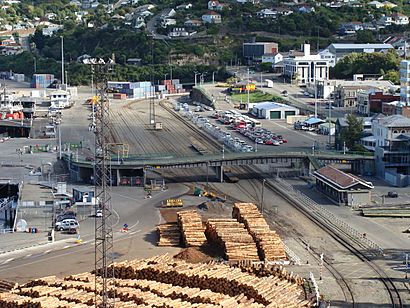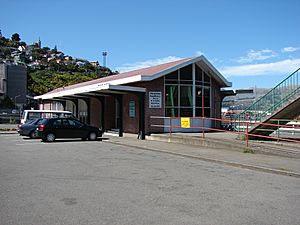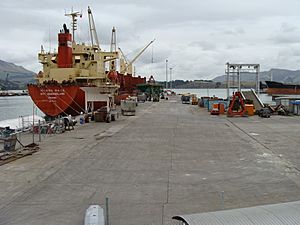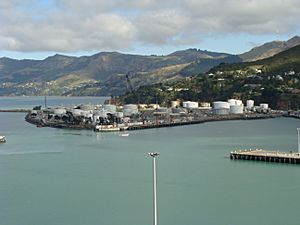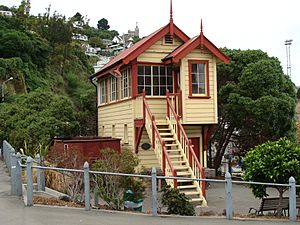Lyttelton railway station facts for kids
The Lyttelton railway station is a train station in Lyttelton, New Zealand. It's the end point of the Main South Line, a major railway line that goes all the way to Invercargill in the South Island of New Zealand.
Over the years, three different train stations have been built in Lyttelton. The newest one is still used today for railway activities. Both freight (goods) and passenger trains have used Lyttelton station since it first opened in 1867.
After suburban passenger trains stopped running in the 1970s, moving goods became the main job for the railway at Lyttelton. Passenger trains are now a small part of its use. In recent years, Tranz Scenic has run special tourist trains from the station during summer. These trains are mostly for people on cruise ships. There have been ideas to bring back regular passenger trains from Lyttelton, but this isn't likely to happen soon.
Trains at Lyttelton have used all three types of power: steam, electric, and diesel. Steam trains were common until the late 1960s. Electric trains ran from 1929 to 1970. Now, all trains at Lyttelton use diesel power.
You can connect to other public transport near Lyttelton station. Metro bus routes 28 and 35 have a stop close by. The Diamond Harbour ferry leaves from a jetty across from the station. Until 1976, the Steamer Express inter-island ferries also connected with trains at Lyttelton.
Contents
Station History
Early Stations
First Station (1867–1873)
The first Lyttelton train station opened on 9 December 1867. This happened at the same time as the official opening of the Lyttelton Rail Tunnel. About 500 people watched the first train arrive. Some early passengers felt the station looked unfinished and temporary.
The station building was a small wooden structure. It was about 16 feet by 35 feet. Trains could move close to ships to transfer cargo. This was done using special turntables for wagons.
Second Station (1873–1963)
Plans for the second station were made in January 1873. The manager of the Canterbury Provincial Railways wanted roofs (verandas) over the platforms. He felt people shouldn't have to wait outside in bad weather. This new station opened in August 1873.
This second station served Lyttelton for 90 years. It had some changes and additions over time. For example, the platform was made longer in 1903. This allowed it to hold two more train carriages.
The station needed many repairs over its long life. In 1910, engineers noted many problems. They wanted a new station, but were told to just fix the old one. By the 1950s, the buildings were in poor condition. Finally, in the late 1950s, a decision was made to replace it.
Plans for a New Station (1920s)
By the 1920s, the Lyttelton station was getting old. There were plans to make the train line between Christchurch and Lyttelton electric. People thought this would be a good time to build a new station in Lyttelton. A new station was also being planned for Christchurch.
The Minister of Railways even included a new Lyttelton station in the 1924 work plans. Designs for the station were ready by 1927. The Railways Department promised to build it after the Lyttelton rail tunnel was electrified. But nothing happened. In 1928, the stationmaster was told the new station was put off indefinitely.
The idea of a new station came up again in the mid-1930s. The station's condition had gotten worse. In 1936, the Minister of Railways said a new station was being considered. But he couldn't say when it would happen. The station was finally painted in 1940. This showed that plans for a new station were put on hold.
Modern Station and Yard
Third Station (1963 – Present)
In 1957, railway engineers decided Lyttelton was next for a station upgrade. After checking the old building, they chose to replace it instead of fixing it. They started planning a new building in 1959.
Even before the third station opened, there were questions about how many passengers would use it. The Lyttelton road tunnel was almost finished. This tunnel would make it much easier to travel by road between Lyttelton and Christchurch. People worried that a new train station might not be needed. Despite this, the Minister of Railways approved the new station in 1962.
As part of the changes, the Goods Office moved to another building. This building also housed the station master and other railway staff. Work on the new station began in January 1963. The old station was used while the new one was being built.
The first part of the new station opened on 10 June 1963. The old station was then taken down bit by bit. The official opening ceremony for the new station was on 14 October 1963. The mayor of Lyttelton and other important people attended. The mayor believed that both road and rail transport could work together for Lyttelton.
A new goods shed was ready in Lyttelton in December 1970. Years later, in 1988, this goods shed was closed. In 1972, there was a plan to change the station building. This was to make space for all the railway staff working in Lyttelton.
In 1980, part of the station platform was shortened. This was because the curved section of the platform caused problems. This part of the platform was no longer needed.
Sidings and Wharves
Many extra railway tracks, called sidings, used to serve businesses near Lyttelton station. Most of these sidings are no longer used. However, some sidings that served oil companies are still in place.
The wharves at Lyttelton port were very important for train operations. The Railways Department managed all railway work at the port until the mid-1970s. Then, the port became a container port. Management of the wharves was slowly moved to the Harbour Board.
Wharf No. 2
Wharf no. 2 was very well-known to train travelers. It was also called the Steamer Express Wharf. For over 70 years, it was where inter-island ferries connected with "boat trains." These trains ended their journey at Lyttelton. After 1902, passengers could transfer directly between ferries and trains on the wharf.
The wharf had railway tracks and other facilities. These included a wooden platform with a roof for passengers. There was also a cafeteria and an office building. This office was used by both the Railways Department and the Union Company.
In 1965, the Lyttelton Harbour Board decided to build a new passenger terminal on wharf no. 2. This was for new roll-on/roll-off ferries. The Harbour Board asked the Railways Department to help with the cost. The Department felt they shouldn't pay much. They believed the Union Company would benefit most.
Construction of the new terminal finished in December 1965. The Union Company started using its new ferries and facilities. After the inter-island ferries stopped running in 1976, the roof on the wharf was no longer needed. It was eventually sold to the Harbour Board. In 1979, the railway connection to wharf no. 2 was also removed.
How the Station Operated
The first freight train went through the tunnel to Lyttelton in late November 1867. The first passenger train arrived on 9 December 1867. After opening, trains ran three times a day between Lyttelton and Christchurch.
For many people, Lyttelton was a key place to transfer for journeys between the North and South Islands. From 1895, and nightly from 1905, a ferry service ran between Wellington and Lyttelton. This was the main way people traveled between the islands. Passengers had to move their own luggage between the ferries and the trains. From 1902, express trains pulled up right next to the ferries on the wharf. This made it easier to transfer passengers and luggage.
A big improvement came on 14 February 1929. This is when electric trains started running from Christchurch to Lyttelton. This was the first suburban electric train service in New Zealand. It was very popular with both train staff and passengers. It meant no more smoke in the tunnel. Electric trains ran 20 times a day. But by 1970, it became too expensive to run them. The line was then changed back to non-electric.
Diesel locomotives started to be used at Lyttelton. By 1969, four Hitachi rail tractors were assigned there for shunting (moving wagons). However, steam locomotives were still used for some trains until the late 1960s.
Transferring mail between the inter-island ferries and trains used to be a big part of Lyttelton's work. Mail was put in bags or crates and moved to ships. Local trains carried mail between Christchurch and the port. But after air mail services started in the 1960s, less mail was sent by ferry.
Fewer and fewer passengers used the trains between Christchurch and Lyttelton after the Lyttelton road tunnel opened in 1964. When the electric trains stopped, diesel trains took over. But this didn't stop the decline in passengers. So, the service was cancelled on 28 February 1972. The special "boat train" services that connected with the ferries were cancelled in 1976. This happened when the inter-island ferry services also stopped.
In 1982, a railway manager described the types of goods handled at Lyttelton. Lyttelton was a busy freight yard. It handled export coal, containers, oil, and meat. It also stored many wagons.
Lyttelton Station Today
The station building that opened in 1963 is still there. It is now owned by KiwiRail. The land behind the station is owned by the Lyttelton Port of Christchurch. Only authorized people can go there. The original Lyttelton station signal box also still exists near the station building. All railway facilities on wharf no. 2 have been removed.
Lyttelton is still a very busy place for freight trains. It serves the Lyttelton Port of Christchurch. Many goods pass through the port, including dairy products, coal, timber, vehicles, and other container freight. Railway staff who manage container traffic used to be based at Lyttelton station. Now, all Lyttelton-based railway staff work from the station building. Some rooms in the station building are used by railway operations staff. The station building has also been rented out to other businesses, like a transport company and the Lyttelton Information Centre.
Since the summer of 1997–1998, Tranz Scenic has offered day trips for cruise ship passengers. These trips go from Lyttelton to Arthur's Pass. At first, passengers took a bus to Christchurch, then boarded the TranzAlpine train. Since 2000, special trains pick up passengers directly from Lyttelton railway station. They take them straight to Arthur's Pass. These trains use spare carriages from the TranzAlpine fleet.
This operation uses some office space in the station building. It also uses the station area to move passengers between trains and buses. Some tour groups travel by train to Arthur's Pass and return to Lyttelton. Other groups do only half the journey by train and finish by bus. The track next to the station platform has been removed. So, passengers get on or off trains outside the station building. Buses then take passengers between the trains and the wharf for safety reasons. The number of special trains changes each season, but business has generally been good.
The Lyttelton Port Company plans to add a longer siding at Lyttelton. This new siding will hold 24 wagons. It will replace two shorter sidings. This will help move trains faster. This is part of a plan to increase the port's container capacity. The port also wants to use its rail shuttle service more often. In the future, the port hopes to move its operations to new wharves. This would allow them to remove the current wharves in front of the town.
Future Ideas
Many people have asked for passenger train services to return to Christchurch. Several studies have looked into this idea. Some of these studies have suggested new suburban services from Lyttelton. However, there are currently no plans to make any of these ideas happen.


